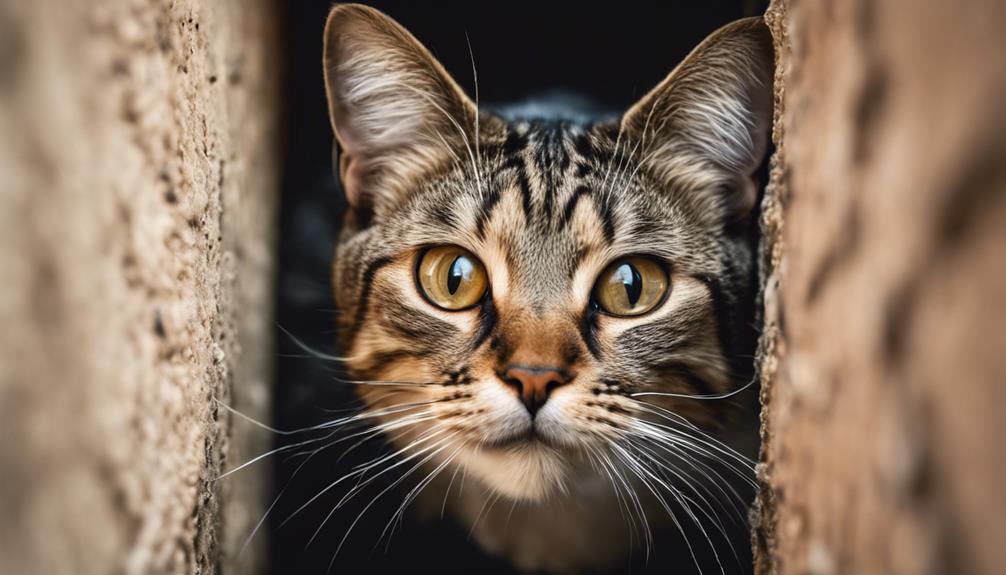Cat ambushes are usually playful, driven by their instinct to hunt and interact, not to harm us intentionally. Signs like dilated pupils and stealthy movements often precede these pounces. Boredom, excess energy, or a need for attention can trigger ambushes. To prevent them, engage your cat in playtime, avoid sudden movements, and provide safe spots. Stress or lack of stimulation can also lead to ambush behavior. Seeking professional advice may be necessary if stress triggers are present. By understanding these behaviors, you can build a stronger bond with your feline friend.
Key Takeaways
- Cat ambushes are playful behaviors, mimicking hunting instincts.
- Ambushes indicate a need for interaction or release of energy.
- Understanding cat body language can help anticipate ambushes.
- Providing ample playtime and safe spaces can prevent ambushes.
- Differentiating between playful pouncing and actual ambush behavior is crucial.
Understanding Cat Ambush Behavior
Understanding the cat ambush behavior is essential for fostering a harmonious relationship with our feline companions. Cats engaging in ambush behavior are often motivated by their innate play behavior and hunting instincts. When a cat pounces on us unexpectedly, it's not out of malice but rather a way for them to have fun and simulate hunting.
Providing interactive play sessions can help redirect this behavior towards appropriate outlets, such as toys or designated playtime. Cats may ambush us when they're feeling bored, full of excess energy, or simply seeking some interaction. By understanding and respecting their need for ambush play, we can't only prevent any misunderstandings but also strengthen the bond we share with our feline friends.
Signs of Impending Cat Ambush

When your cat's pupils dilate and they fixate on a target, be ready for a potential ambush. Watch out for a lowered body, flattened ears, and tail twitching – classic signs that an attack is imminent.
Keep an eye out for stealthy movements and sudden bursts of speed, as your feline friend may be planning a surprise pounce!
Stealthy Movement Patterns
Cats often exhibit stealthy movement patterns, such as crouching low and moving quietly, signaling their impending ambush. When your feline companion lowers their body close to the ground, with dilated pupils and a fixed gaze on their target, it's a clear sign that they're preparing to pounce.
These subtle body language cues reveal their intent to surprise you with a playful attack. You might notice your cat hiding behind furniture or lurking in the shadows, patiently waiting for the perfect moment to strike.
Their quick, sudden movements followed by a swift leap are all part of their natural hunting instincts. So, next time you spot your cat moving with stealth and focus, be prepared for a possible ambush full of feline fun!
Tail Flicking Behavior
As your cat's tail flicks back and forth with heightened arousal, signaling anticipation of a pounce or ambush, be alert for the accompanying dilated pupils and focused gaze on their target. This tail flicking behavior is a classic sign of predatory instincts kicking in, a prelude to a playful or hunting ambush. When you notice this behavior, it's time to brace yourself for a potential sneak attack from your feline friend. Below is a visual representation to help you understand your cat's body language better:
| Tail Flicking Behavior | ||
|---|---|---|
| Signs | Description | Implications |
| Tail flicking | Swishing back and forth | Heightened arousal |
| Dilated pupils | Enlarged black centers | Focused attention |
| Focused gaze | Locked onto target | Ready to strike |
Triggers for Cat Ambushes

Often triggered by sudden movements or noises that startle us, cat ambushes can catch us off guard during our daily interactions with our feline companions. Understanding the triggers for these ambushes is vital in fostering a harmonious relationship with our cats.
Cats may pounce unexpectedly during play, driven by their natural hunting instincts or a burst of energy. Additionally, feelings of being threatened or territorial can prompt ambush behavior, especially in homes with multiple cats vying for space. Changes in the environment or disruptions in routine can also lead to ambushes as a response to stress.
By recognizing these triggers and being mindful of our movements and the environment, we can help minimize surprise attacks from our furry friends. Establishing a safe and secure space for our cats to reduce feelings of threat or anxiety that may lead to ambush behavior is crucial.
Body Language Cues Before Ambush

Recognizing subtle body language cues before an ambush can help cat owners anticipate and respond to their feline companion's behavior effectively. When dealing with an aggressive cat, it's crucial to be aware of the signs that may precede an ambush.
Here are some key body language cues to look out for:
- Dilated Pupils and Focused Gaze: Dilated pupils and a fixed stare can indicate that your cat is gearing up for an ambush.
- Pouncing Posture: If your cat adopts a posture with its rear end raised and tail twitching, it might be preparing to launch into an ambush.
- Crouched Position: Cats may lower their bodies and slightly retract their ears before ambushing, mimicking their natural hunting instincts.
- Freezing Followed by Swift Movement: A sudden freeze followed by a quick movement towards you could be a clear sign that an ambush is imminent.
Preventing Cat Ambush Attacks

To prevent ambush attacks by your cat, guarantee ample playtime and exercise opportunities to channel their energy effectively. Cats have natural hunting instincts, and when they don't have an outlet for this energy, they may resort to ambushing behaviors. Interactive toys and engaging play sessions can help satisfy these instincts and reduce the urge to ambush.
Establishing a predictable routine for your cat can also minimize the element of surprise that often triggers ambush behavior. Avoid sudden movements or loud noises that can startle your cat, as this may lead to an ambush response. Providing hiding spots or safe spaces where your cat can retreat to when feeling overwhelmed is essential in reducing the likelihood of ambush attacks.
Handling a Cat Ambush Safely

When handling a cat ambush, remember to avoid sudden movements to prevent escalating the situation.
Use a calm and soothing voice to reassure the cat during an ambush.
Slowly back away from the cat if you feel threatened by the ambush.
Cat Ambush Prevention
Taking proactive steps to prevent cat ambushes is essential for maintaining a harmonious relationship with your feline friend. Here are some practical tips to help you handle a potential ambush situation with your cat:
- Engage in interactive play: Redirect your cat's hunting instincts towards toys to prevent aggressive ambush behavior.
- Create a cat-friendly environment: Provide hiding spots and elevated perches for your cat to reduce surprise attacks.
- Read your cat's body language: Watch for signs like crouching or tail twitching that may indicate an upcoming ambush.
- Avoid triggering instincts: Steer clear of sudden movements or loud noises that could provoke predatory responses and lead to ambushes.
Reacting to Surprise Attacks
Staying calm and using gentle, slow movements can help safely handle a surprise cat ambush without escalating the situation.
If a cat is aggressive during an ambush, sudden movements or loud noises can worsen the encounter. Instead, try to redirect their focus by offering a toy or treat to shift their attention away from the ambush behavior.
It's important to avoid punishing or yelling at the cat as this can heighten fear and aggression.
By providing safe hiding spots and escape routes in your home, you can help prevent future ambushes and reduce stress for your cat.
Setting Boundaries Firmly
In handling a cat ambush safely, it's important to establish firm boundaries with clear limits and consistent reinforcement of positive behaviors. When dealing with such behavior, remember to:
- Remain Calm: Keep a composed attitude to avoid escalating the situation.
- Use Distractions: Utilize toys or treats to redirect your cat's focus to more suitable activities.
- Avoid Punishment: Refrain from using punishment as a response, as it can lead to increased fear and aggression.
- Provide Secure Spaces: Guarantee your cat has vertical spots and hiding places to retreat to when feeling stressed, reducing the chances of ambush behavior recurring.
Redirecting Cat Ambush Behavior
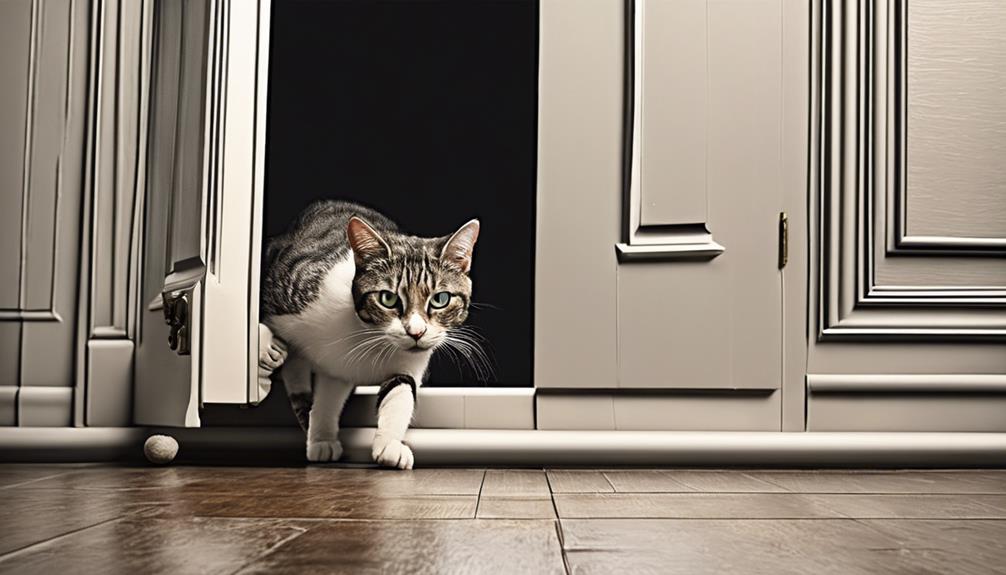
To redirect cat ambush behavior effectively, engaging in interactive play sessions and providing toys that mimic prey movements is essential. Interactive play is a fantastic way to channel your cat's hunting instincts in a positive and engaging manner. By using wand toys or laser pointers, you can stimulate your cat's natural behaviors and redirect their focus away from ambushing you. These play sessions not only provide physical exercise but also mental stimulation, satisfying their instincts in a safe and controlled environment.
Introducing toys that mimic prey movements, such as small furry toys that move erratically, can further entice your cat's hunting instincts. By engaging with these toys during play sessions, you can redirect their ambush behavior towards appropriate targets. Creating a stimulating environment with hiding spots and climbing structures can also help reduce ambush behavior by giving your cat alternative outlets for their energy.
Consistent daily play sessions and enrichment activities are key to managing ambush behavior effectively. By satisfying your cat's hunting instincts through play, you can foster a stronger bond and minimize any unwanted ambushes towards you.
Ambushes Vs. Playful Pouncing

Distinguishing between ambushes and playful pouncing in cats involves recognizing subtle behavioral cues and understanding their motivations. When your furry friend engages in playful pouncing, they're likely expressing their natural hunting instincts in a fun and safe manner. Here are some key indicators to help you differentiate between the two behaviors:
- Relaxed Body Posture: During playful pouncing, your cat will exhibit a more relaxed and playful body language, with their muscles appearing loose rather than tense.
- Tail Wagging: A gently swaying tail is a common sign of playful intent, indicating that your cat is in a light-hearted mood.
- Non-Aggressive Vocalizations: Cats engaging in playful pouncing often make softer and more playful sounds, such as chirps or trills, rather than aggressive hissing or growling.
- Interactive Play Opportunities: Providing your cat with interactive play sessions and appropriate outlets for their hunting behavior can help reduce ambush-like behaviors and encourage more playful interactions.
Understanding these cues can help strengthen the bond between you and your feline companion, fostering a harmonious relationship built on trust and mutual enjoyment.
Ambushes: Normal Cat Behavior?
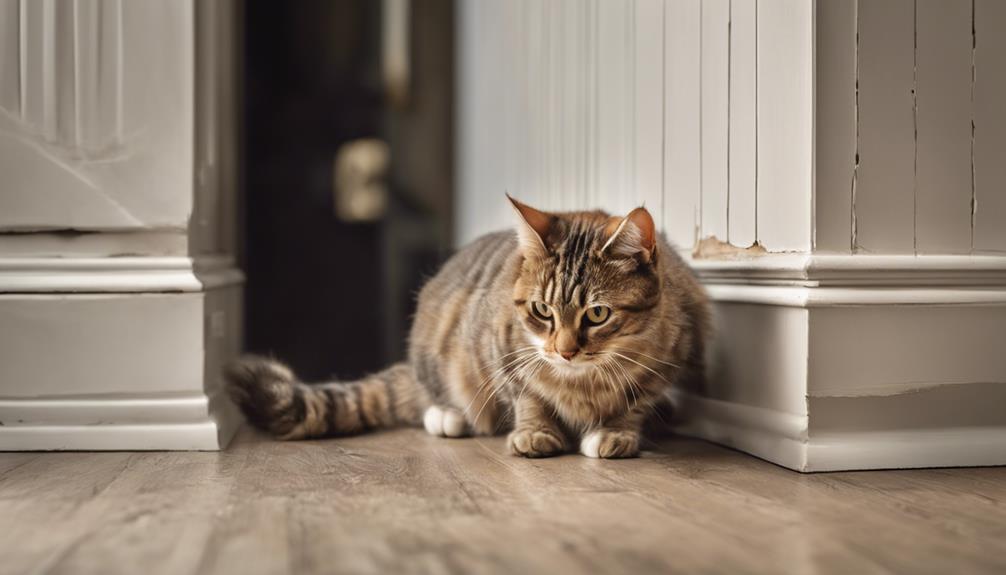
Ambushing behavior in cats is a common instinctual behavior linked to their hunting and play activities. Cats may surprise attack their owners as a way to engage in interactive play or satisfy their predatory instincts.
Understanding this normal cat behavior can help strengthen the bond between cats and their owners through engaging play sessions.
Cats Hunting Instinct
Exploring the depths of a cat's predatory nature reveals that ambushes are a fundamental aspect of their hunting instinct. Cats' innate drive to stalk and pounce is deeply ingrained in their DNA, even when they're domesticated. Here's why this behavior is completely normal:
- Primal Hunting Instinct: Ambushing is a manifestation of your cat's primal hunting instincts, showing their natural prowess as skilled predators.
- Playful Interaction: When they ambush you during play, it's their way of engaging with you in a fun and interactive manner.
- Exercise and Practice: Kittens use ambushes to hone their hunting skills, while adult cats see it as a form of exercise and play.
- Bond Strengthening: Understanding and accepting this behavior can strengthen the bond between you and your feline friend, creating a deeper connection through shared experiences.
Surprise Attacks Common
When considering the behavior of cats, it becomes evident that surprise attacks, commonly known as ambushes, are a typical and expected aspect of their natural instincts and interactions.
These ambushes aren't meant to harm but rather stem from their hunting and stalking instincts, often displayed as playful behavior. Whether it's pouncing on a toy or springing out from behind a door, cats use ambushes to engage with their environment and release excess energy.
If you have more than one cat, ambushes can also be a way for them to interact with each other, displaying their social dynamics through playful attacks. Understanding that ambushes are a normal part of feline behavior can help you appreciate and manage these surprise attacks better.
Ambushes in Multi-Cat Homes
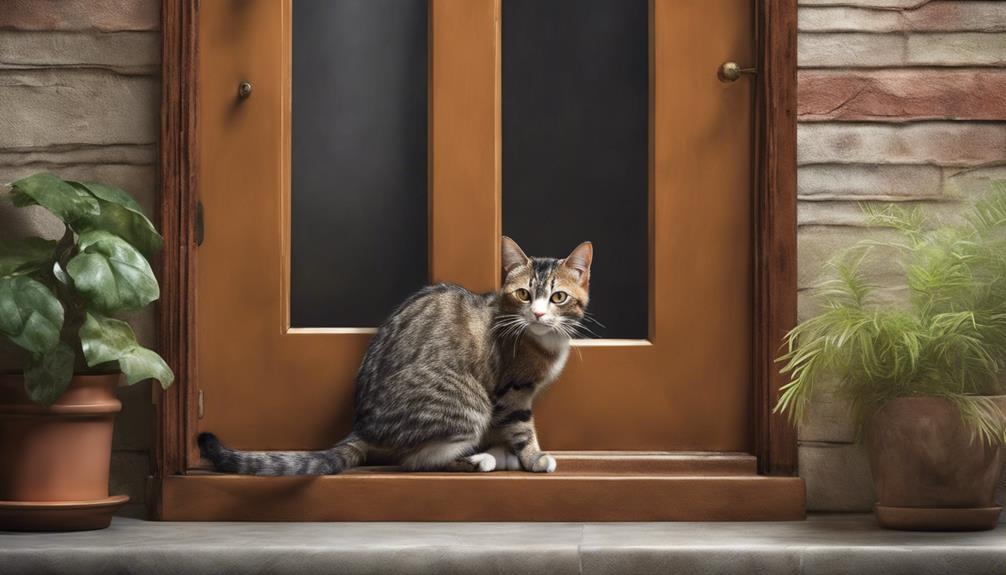
In multi-cat households, feline ambushes can often arise as a result of playful interactions or territorial disputes among the resident cats. Here are some key points to take into account when dealing with ambushes in multi-cat homes:
- Competition for Resources: Cats may ambush each other when vying for essentials like food, toys, or attention.
- Hierarchy Establishment: Ambushing behavior can be a way for cats to establish a hierarchy and determine their positions within the group.
- Dominance Assertion: Some ambushes occur as a means for cats to assert dominance over others in the household.
- Establishing Boundaries: Ambushes can also be a way for cats to mark and maintain their territories in the shared living space.
To help reduce ambushes in multi-cat homes, contemplate providing separate resources for each cat and engaging them in enrichment activities to keep them mentally stimulated and less likely to engage in ambush behavior.
Ambushes in Indoor Vs. Outdoor Cats

Indoor cats may surprise their owners with ambushes as a playful display of their hunting instincts, often seen during interactive play sessions. While outdoor cats are more likely to ambush prey like birds or rodents, they too can exhibit ambush behavior towards their owners. These ambushes, whether indoors or outdoors, are triggered by sudden movements, noises, or perceived threats in their surroundings. It's essential to recognize that ambush behavior in cats serves various purposes—it can be a form of exercise, mental stimulation, or a way to release pent-up energy.
To better understand the differences in ambush behavior between indoor and outdoor cats, let's take a closer look:
| Ambushes in Indoor Cats | Ambushes in Outdoor Cats |
|---|---|
| Playful displays of hunting instincts | Predatory behavior towards prey |
| More focused on owners during interactive play | Targets prey like birds or rodents |
| Often a way to release energy | Can be a hunting strategy |
| Triggered by sudden movements or noises | Responds to environmental stimuli |
Ambushes Due to Lack of Stimulation

Lacking mental and physical stimulation can prompt cats to ambush their owners. When a cat can't engage in enough activities to satisfy their natural instincts, they may resort to surprising attacks.
To address this issue, consider the following:
- Insufficient Playtime: Cats need regular play sessions to stay mentally and physically active. Without this stimulation, they may seek excitement through ambush behavior.
- Lack of Environmental Enrichment: A cat can't thrive in a dull environment. Providing interactive toys, scratching posts, and climbing structures can prevent boredom-induced ambushes.
- Release of Stored Energy: Ambushes allow cats to release stored energy and exhibit their hunting skills. Engaging in play mimics hunting behavior, reducing the need for surprise attacks.
- Bonding Through Play: Regularly engaging with your cat in interactive activities not only prevents ambushes but also strengthens your relationship. It's a win-win for both of you!
Ambushes Due to Stress or Anxiety

When our feline friends feel stressed or anxious, they may resort to ambush behavior as a coping mechanism. These surprise attacks are often a way for cats to establish control or alleviate their feelings of being overwhelmed.
Stress Triggers Cat Ambushes
In stressful situations, cats may exhibit ambush behavior towards their owners as a defensive response. This behavior is often triggered by various stressors in their environment.
Here are some common stress triggers that can lead to cat ambushes:
- New Pets: Introducing a new furry friend can disrupt your cat's sense of territory and cause stress.
- Moving to a New Home: Changes in the living environment can be overwhelming for cats and lead to feelings of insecurity.
- Loud Noises: Sudden loud sounds can startle cats and trigger their defensive instincts, resulting in ambush behavior.
- Unfamiliar Visitors: Strangers in the house can make cats feel anxious and prompt them to ambush in an attempt to assert control.
Understanding and addressing these stress triggers can help create a calmer and safer environment for your feline friend.
Anxiety Leads to Ambushes
Experiencing stress or anxiety can prompt cats to engage in ambush behavior towards their owners as a defensive response. When our feline friends feel overwhelmed or insecure, they may resort to sudden attacks as a way to cope with their emotions.
Signs of anxiety-induced ambushing behavior include hiding, excessive grooming, and even aggression towards other pets or people in the household. Creating a safe and predictable environment for our cats, along with providing enriching activities, can help decrease ambush behavior caused by anxiety.
If your cat continues to exhibit ambushes, seeking guidance from a veterinarian or animal behaviorist is advisable to address the underlying anxiety issues. By understanding and addressing the root cause of the ambushing behavior, we can help our cats feel more secure and content in their environment.
Addressing Cat Ambushes
Addressing cat ambushes due to stress or anxiety involves understanding triggers and implementing calming strategies. Here are some ways to help your feline friend feel more secure and reduce ambush behavior:
- Maintain a Consistent Routine: Cats thrive on predictability, so try to keep feeding times and play sessions consistent.
- Create Safe Spaces: Provide hiding spots and elevated perches where your cat can retreat when feeling stressed.
- Engage in Interactive Play: Regular interactive play sessions can help redirect your cat's energy and provide mental stimulation.
- Use Calming Techniques: Consider using pheromone diffusers or calming sprays in your home to create a relaxing environment for your cat.
Ambushes Due to Medical Issues
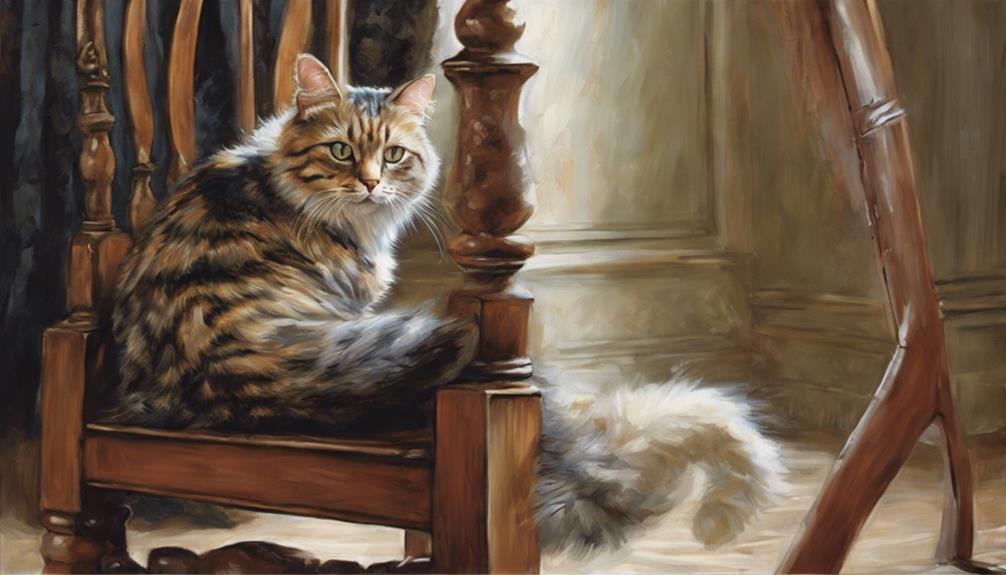
During times of medical distress, cats may resort to ambushing behavior towards their owners as a means of communicating discomfort or pain. Medical conditions like dental pain, arthritis, or hyperthyroidism can trigger such behavior in cats. When our feline companions feel vulnerable or threatened due to underlying health issues, they may express their distress through ambushes.
To address ambush behavior stemming from medical conditions, it's important to have our cats examined by a veterinarian. Through a thorough check-up, potential health problems can be identified and treated promptly. Seeking professional guidance not only helps in understanding the root cause of the behavior but also guarantees that our cats receive appropriate treatment to improve their well-being.
Seeking Professional Help for Cat Ambushes

When our cats exhibit ambush behavior, seeking professional help from certified animal behaviorists or veterinary behaviorists can provide valuable insights and tailored interventions to address the underlying causes effectively.
Here are some ways these professionals can help your cat:
- Assessment: Professionals can thoroughly assess your cat's behavior to understand why the ambushes are happening.
- Recommendations: They can suggest behavior modification techniques, environmental changes, and even medication to help manage the ambush behavior.
- Tailored Plan: Working with these experts allows for the creation of a personalized plan specifically designed to reduce the likelihood of future ambushes.
- Critical: Seeking professional help is critical for ensuring the safety and well-being of both your cat and yourself when dealing with ambush behavior.
Frequently Asked Questions
Why Does My Cat Try to Ambush Me?
When our cat ambushes us, it's often because they're playfully mimicking their hunting instincts. Providing enrichment, interactive play, and mental stimulation can help redirect this behavior. Understanding their motives helps manage it effectively.
Is My Cat Trying to Dominate Me?
We're not being dominated by our cat when they ambush us; it's just their natural hunting instincts at play. Understanding this behavior strengthens our bond. Let's cherish these playful moments and engage with interactive toys together.
Does My Cat See Me as a Threat?
We're not seen as threats by our cats. They might ambush out of playfulness or hunting instincts. Redirecting their energy with interactive toys can help. Younger cats or those with high prey drive often exhibit this behavior.
How Do You React When a Cat Attacks You?
When a cat attacks, we stay calm, redirect their focus with toys or treats, and avoid physical punishment. Positive reinforcement like clicker training helps encourage good behavior. Seek professional help if attacks persist for proper management.
Conclusion
To sum up, understanding why our cats ambush us is key to preventing surprise attacks. By recognizing the signs, triggers, and body language cues, we can better anticipate and avoid these situations.
Providing proper stimulation, reducing stress, and addressing any medical issues are essential in keeping our feline friends happy and relaxed. Remember, just like a game of cat and mouse, being one step ahead can lead to a harmonious relationship with our furry companions.
